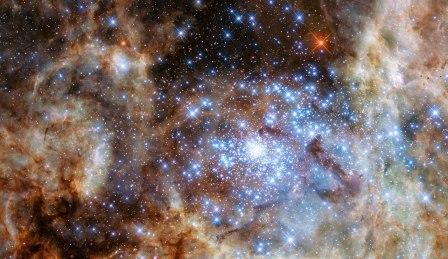
The young and dense star cluster R136 can be seen at the lower right of the image. Photo: NASA, ESA, P Crowther (University of Sheffield).
PARIS (BNS): Astronomers have identified nine monster stars with masses over 100 times the mass of the Sun in the star cluster R136.
This makes it the largest sample of very massive stars identified to date, ESA said.
An international team of scientists using the NASA/ESA Hubble Space Telescope has combined images taken with the Wide Field Camera 3 (WFC3) with the unprecedented ultraviolet spatial resolution of the Space Telescope Imaging Spectrograph (STIS) to successfully dissect the young star cluster R136 in the ultraviolet for the first time.
R136 is located in the Tarantula Nebula within the Large Magellanic Cloud, about 170 000 light-years away. The young cluster hosts many extremely massive, hot and luminous stars whose energy is mostly radiated in the ultraviolet.
The study was able to reveal a total number of nine very massive stars in the cluster, all more than 100 times more massive as the Sun. However, the current record holder R136a1 does keep its place as the most massive star known in the Universe, at over 250 solar masses.
The detected stars are not only extremely massive, but also extremely bright. Together these nine stars outshine the Sun by a factor of 30 million.
The scientists were also able to investigate outflows from these behemoths, which are most readily studied in the ultraviolet. They eject up to an Earth mass of material per month at a speed approaching one percent of the speed of light, resulting in extreme weight loss throughout their brief lives.
The ability to distinguish ultraviolet light from such an exceptionally crowded region into its component parts, resolving the signatures of individual stars, was only made possible with the instruments aboard Hubble, said Paul Crowther from the University of Sheffield, UK, and lead author of the study.
In 2010 Crowther and his collaborators showed the existence of four stars within R136, each with over 150 times the mass of the Sun. At that time the extreme properties of these stars came as a surprise as they exceeded the upper-mass limit for stars that was generally accepted at that time.
Now the new census has shown that there are five more stars with more than 100 solar masses in R136. The results gathered from R136 and from other clusters also raise many new questions about the formation of massive stars as the origin of these behemoths remains unclear, the study said.
In order to find answers about the origin of these stars the team will continue to analyse the gathered datasets.
The results are published in the Monthly Notices of the Royal Astronomical Society.
 Previous Article
Previous Article Next Article
Next Article












The Indian Air Force, in its flight trials evaluation report submitted before the Defence Ministry l..
view articleAn insight into the Medium Multi-Role Combat Aircraft competition...
view articleSky enthusiasts can now spot the International Space Station (ISS) commanded by Indian-American astr..
view article